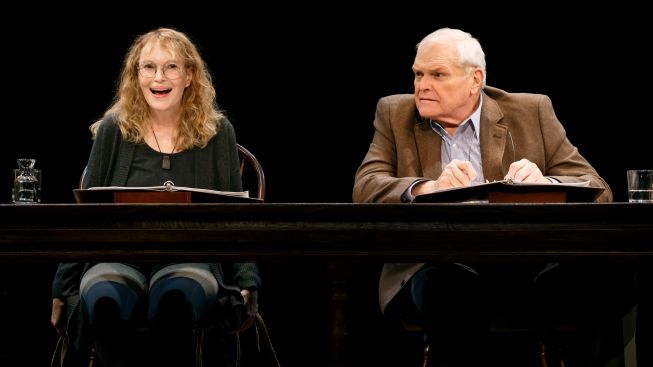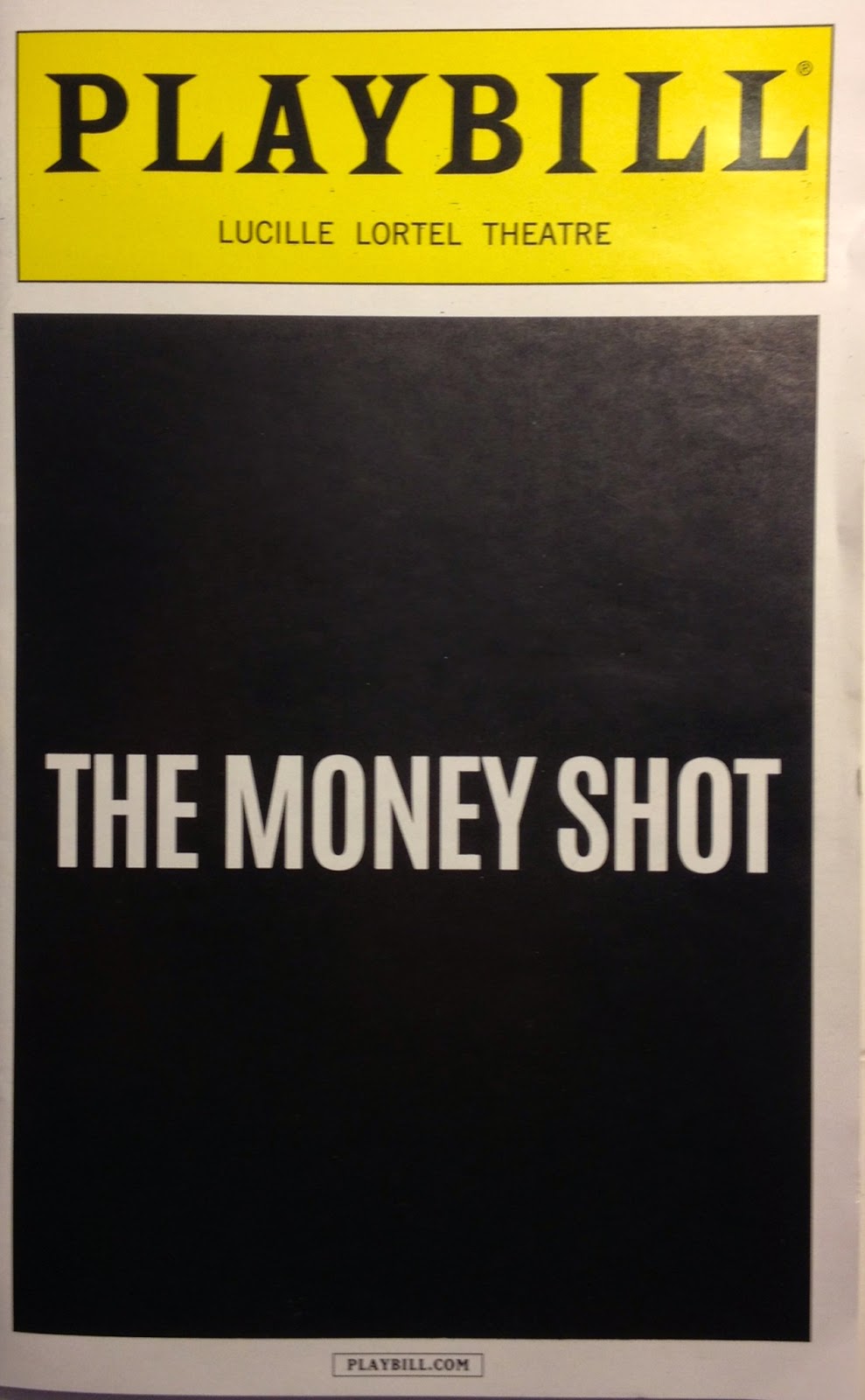76. TO THE BONE
I
recently saw a video posted to Facebook that showed the workings of a humongous
Chinese poultry processing plant, where thousands of workers stand in place chopping,
gutting, and packaging a never-ending supply of chickens moving relentlessly
along on conveyer belts. Dressed in hazmat-like, white protective clothing,
with masks allowing only their vacant eyes to show, they stare soullessly as they
do their robot-like tasks. It’s impossible to imagine what such dehumanizing
work does to a human being, but a glimpse of it is present in Lisa Ramirez’s promising
new play, TO THE BONE, at the Cherry Lane Theatre. The play is being offered as
part of this year’s Theatre: Village festival, titled E Pluribus, in which four
plays “celebrating America’s diversity” are being presented by the Axis
Theatre, the Cherry Lane, the New Ohio Theatre, and the Rattlestick Playwrights
Theater, all prominent West Village venues.
 |
| From left: Lisa Fernandez, Annie Henk, Lisa Martinez. Photo: TO THE BONE company. |
Miss Ramirez, who also offers a
persuasive performance as Olga, one of three Hispanic poultry processors, shines
a light on the dilemma of undocumented immigrant female workers in much the
same way that Elizabeth Irwin does for Mexican busboys in her recent MY MAÑANA
COMES, where the fear of being discovered and deported never ends. Much of the dramatist’s inspiration comes from interviews she conducted with undocumented Latino workers. Ms. Martinez’s
two-act play, which runs a slightly longish two hours, is less consistent and
polished than Ms. Irwin’s, but nevertheless provides a strong evening of
theatre, especially in this vividly directed (by Lisa Peterson) and expertly
performed production.
To establish Olga’s house, the poultry plant, and
other nearby places, designer Rachel Hauck has totally reconfigured the small
theatre at the rear of the Cherry Lane’s lobby from the conventional end stage
arrangement it normally uses. Two rows of seats facing the entrance doors surround
a three-quarters round acting area. There’s a small kitchen at extreme audience
left, in the space between one bank of seats and the other, and a windowed room
at the upstage end of the left seating bank. Up a small flight on the upstage
wall at audience right are the windowed living quarters of Olga’s coworkers, Reina
and Juana, with the bedroom of Lupe, Olga’s daughter, below. A movable doorway
stands in its frame at center and factory lockers are placed in a corner at
audience right. Lining the walls are stacked chicken crates, each with a flickering
light inside to suggest a living presence. Serving multiple purposes, such as for furniture, car seats, and
assembly line platforms, are four more crates. Although the minimalist effect
is generally satisfactory, the layout of the characters’ living arrangements is
rather vague and confusing.
In act one we watch the daily routines of Olga,
Reina (Annie Henk), and Juana (Liza Fernandez) as they get up, do their morning
washing and eating rituals, get driven to their Sullivan County factory by the
Guatamalan cabby Jorge (Dan Domingues), and perform their drearily repetitious jobs.
They are ragged over the loudspeaker by their cruelly demanding American boss,
Daryl (Haynes Thigpen), and drilled to work faster by their Honduran floor
supervisor, Lalo (Gerardo Rodrigues). Lalo is outwardly ruthless, but inwardly
sympathetic, as his own well-being depends on his satisfying Daryl’s demands.
Daryl himself is pressured by orders from “corporate” to provide more product.
Of the three women, Olga, a Salvadoran, is the only one with a green card, while Reina and
Juana are illegals. Olga’s 20-year-old daughter, Lupe (Paola Lázaro-Muñoz), works
at a medical clinic and aspires to attend NYU’s law school. The only plant worker who dares to
oppose the management over issues like work breaks and the like is the feisty Olga,
whose green card gives her a sense of security impossible for the others, one
of whom, Juana, suffers both from physical weakness at work and from psychological issues
that cause her to sleepwalk like a ghost. Before act one ends, we also meet Carmen
(Xochitl Romero), Reina’s young Honduran niece, who has slipped across
the border to find work at the poultry plant. Sad and vulnerable, with a taste
for poetry, she needs money for a parent’s operation.
Act two moves away
from its emphasis on the debilitating effect of work conditions to
the story of Carmen, with whom Jorge soon falls in love. The plot becomes increasingly
melodramatic, with rape and retribution taking prominence. Olga’s fury has no
bounds and helps to inspire events that lead to violence and tragedy. Gone are
the choreographically precise rituals smartly choreographed by Ms. Peterson,
replaced by a more insistently naturalistic performance mode. Although the rape
is intrinsic to the exploitative environment, it seems too clichéd a
device, and muddles the socio-political through line, especially with the
rapist being depicted as a monster of unregenerate evil.
Ms. Ramirez’s spicy
language, much of which I believe is intended to be understood as spoken in
Spanish (albeit with only hints of Hispanic accents), carries the action
forward with dynamic force, and is rendered with the kind of conviction
I found so lacking the other evening in SCENES FROM A MARRIAGE. Ms. Ramirez
acts Olga with fiery anger and determination, making her sympathetic despite her
destructively irate temperament. Ms. Lázaro-Muñoz brings memorable
intelligence, humor, and emotional variety to the chubby, skateboard-riding,
hip-hop reciting Lupe, while Ms. Romero plays Carmen with heartbreaking
sweetness and sorrow. So believable is her air of victimization that I was amazed
to read in her bio that Glamour Magazine chose
her as one of the “Top 10 Funniest Food Bloggers.” Ms. Henk is completely
credible as the determined Reina, and Ms. Fernandez is suitably sensitive as
Juana, although her long, almost whispered monologue to Juana is barely
audible. Both Mr. Domingues and Mr. Rodriguez do excellently by their roles,
and Mr. Thigpen, forced to be a two-dimensional villain, makes Daryl someone
you want to hiss.
Jill BC Du Boff has
outdone herself with an extraordinary sound design combining perfectly chosen
musical selections and auditory effects (including what one would hear in a poultry processing plant), while Russell H. Champa’s lighting does
wonders to create the right emotional atmosphere in the tiny space. Theresa
Squire’s costumes add authenticity to this bedraggled corner of existence.
TO THE BONE
is part slice of life, part expressionism, and part melodrama. You may not like
every part but what remains should be finger lickin’ good.

.jpg)

































.jpg)

